The Cambridge History of Japan, Vol. 1: Ancient Japan
Подождите немного. Документ загружается.

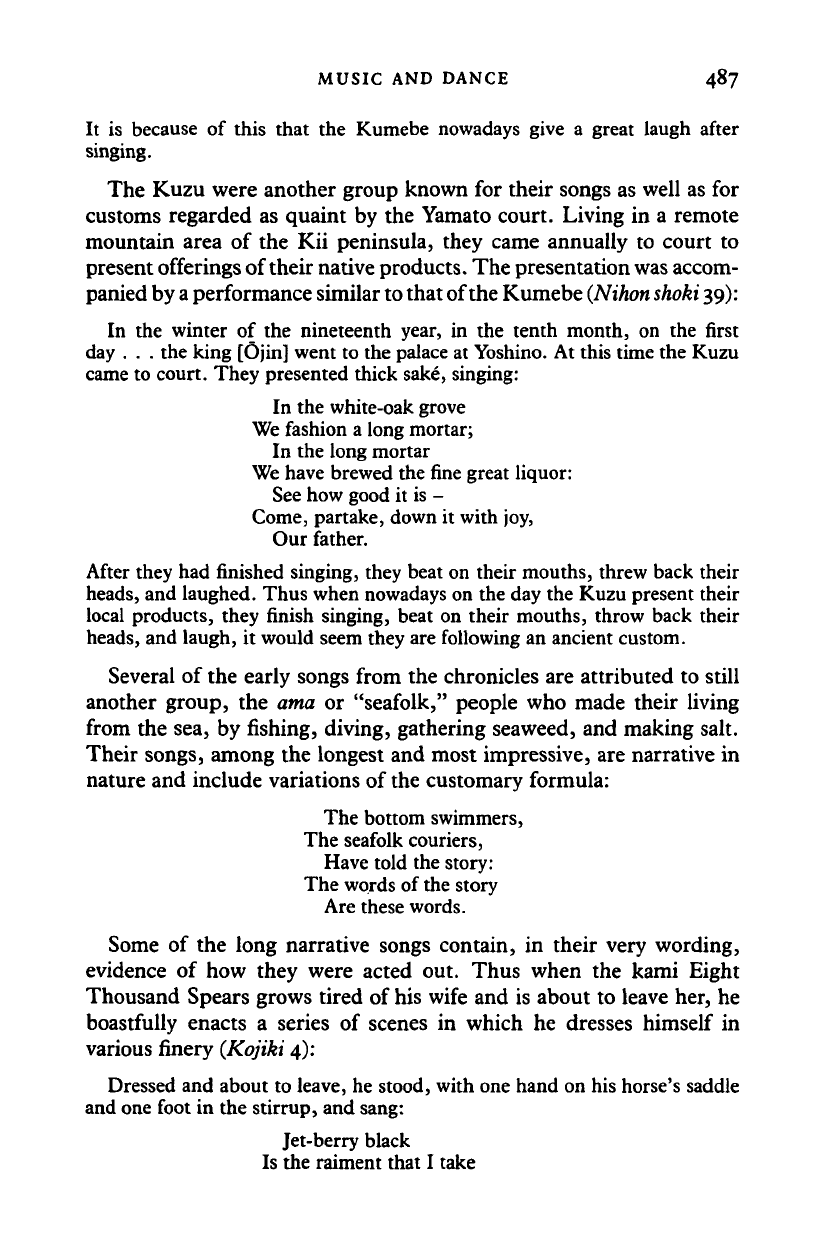
MUSIC AND DANCE 487
It is because of this that the Kumebe nowadays give a great laugh after
singing.
The Kuzu were another group known for their songs as well as for
customs regarded as quaint by the Yamato court. Living in a remote
mountain area of the Kii peninsula, they came annually to court to
present offerings of their native products. The presentation was accom-
panied by
a
performance similar to that of the Kumebe (Nihon
shoki
39):
In the winter of the nineteenth year, in the tenth month, on the first
day . . . the king [Ojin] went to the palace at Yoshino. At this time the Kuzu
came to court. They presented thick sake, singing:
In the white-oak grove
We fashion a long mortar;
In the long mortar
We have brewed the fine great liquor:
See how good it is -
Come, partake, down it with joy,
Our father.
After they had finished singing, they beat on their mouths, threw back their
heads,
and laughed. Thus when nowadays on the day the Kuzu present their
local products, they finish singing, beat on their mouths, throw back their
heads,
and laugh, it would seem they are following an ancient custom.
Several of the early songs from the chronicles are attributed to still
another group, the ama or "seafolk," people who made their living
from the sea, by fishing, diving, gathering seaweed, and making salt.
Their songs, among the longest and most impressive, are narrative in
nature and include variations of the customary formula:
The bottom swimmers,
The seafolk couriers,
Have told the story:
The words of the story
Are these words.
Some of the long narrative songs contain, in their very wording,
evidence of how they were acted out. Thus when the kami Eight
Thousand Spears grows tired of his wife and is about to leave her, he
boastfully enacts a series of scenes in which he dresses himself in
various finery (Kojiki 4):
Dressed and about to leave, he stood, with one hand on his horse's saddle
and one foot in the stirrup, and sang:
Jet-berry black
Is the raiment that I take
Cambridge Histories Online © Cambridge University Press, 2008
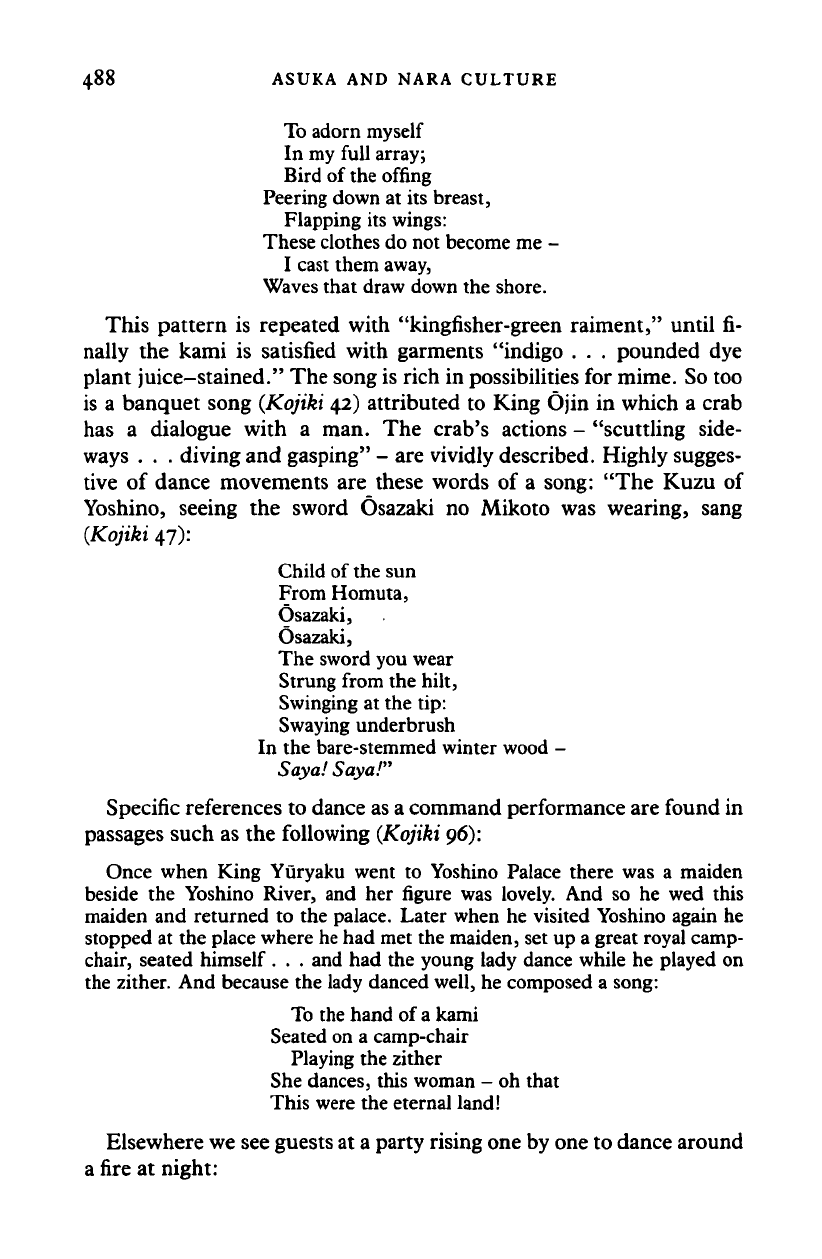
ASUKA
AND
NARA CULTURE
To adorn myself
In my full array;
Bird
of
the offing
Peering down
at its
breast,
Flapping its wings:
These clothes do
not
become me
-
I cast them away,
Waves that draw down the shore.
This pattern is repeated with "kingfisher-green raiment," until fi-
nally the kami is satisfied with garments "indigo . . . pounded dye
plant juice-stained." The song is rich in possibilities for mime. So too
is a banquet song (Kojiki 42) attributed to King Ojin in which a crab
has a dialogue with a man. The crab's actions - "scuttling side-
ways . . . diving and gasping" - are vividly described. Highly sugges-
tive of dance movements are these words of a song: "The Kuzu of
Yoshino, seeing the sword Osazaki no Mikoto was wearing, sang
(Kojiki 47):
Child
of
the
sun
From Homuta,
Osazaki,
Osazaki,
The sword you wear
Strung from the hilt,
Swinging
at
the
tip:
Swaying underbrush
In
the
bare-stemmed winter wood
-
Saya! Saya!"
Specific references
to
dance
as a
command performance are found
in
passages such
as the
following (Kojiki 96):
Once when King Yuryaku went
to
Yoshino Palace there
was a
maiden
beside
the
Yoshino River,
and her
figure
was
lovely.
And so he wed
this
maiden
and
returned
to the
palace. Later when
he
visited Yoshino again
he
stopped
at
the place where he had met the maiden, set up a great royal camp-
chair, seated himself
. . . and had the
young lady dance while
he
played
on
the zither.
And
because the lady danced well,
he
composed
a
song:
To the hand
of
a
kami
Seated on
a
camp-chair
Playing the zither
She dances, this woman
- oh
that
This were the eternal land!
Elsewhere
we
see guests
at a
party rising one
by
one
to
dance around
a fire
at
night:
Cambridge Histories Online © Cambridge University Press, 2008
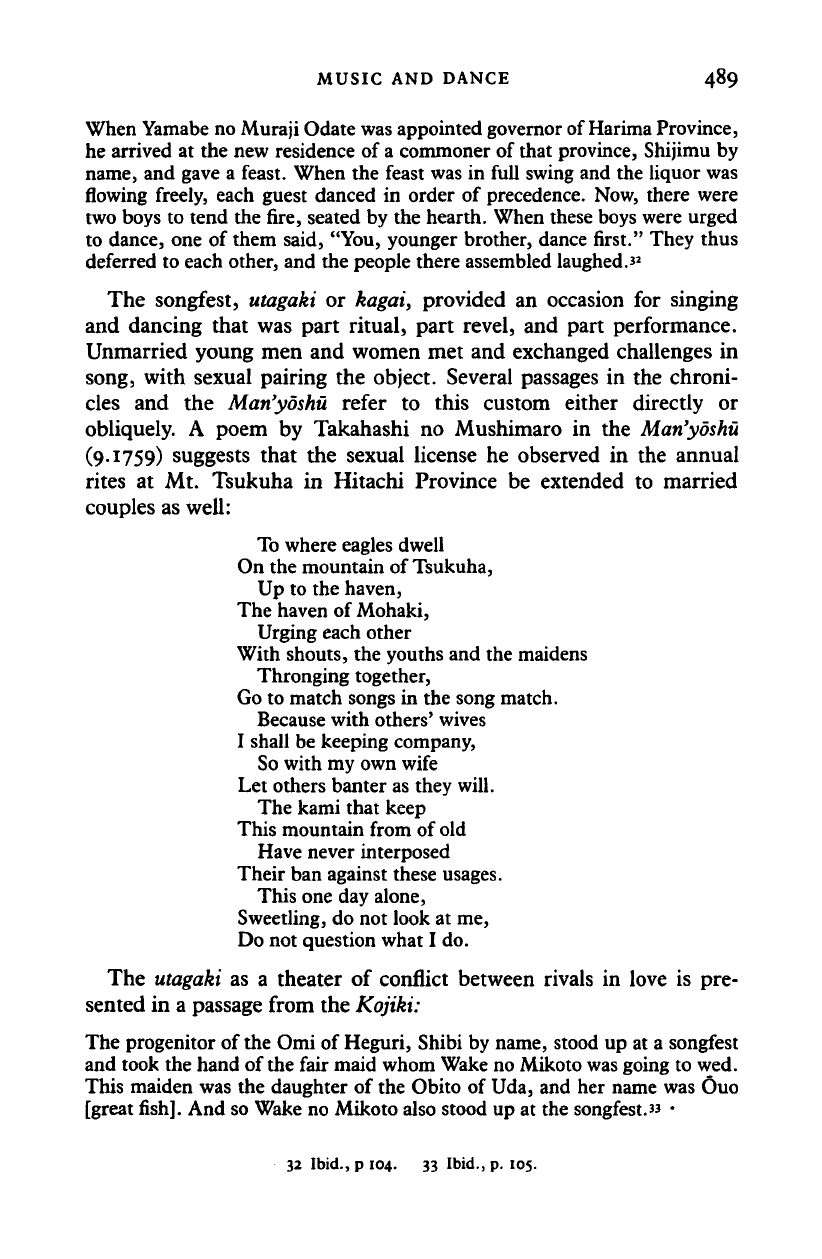
MUSIC
AND
DANCE
489
When Yamabe no Muraji Odate was appointed governor of Harima Province,
he arrived
at the
new residence
of
a commoner
of
that province, Shijimu
by
name,
and
gave
a
feast. When
the
feast was
in
full swing
and the
liquor was
flowing freely, each guest danced
in
order
of
precedence. Now, there were
two boys
to
tend
the
fire, seated
by
the hearth. When these boys were urged
to dance,
one of
them said, "You, younger brother, dance first." They thus
deferred
to
each other,
and
the people there assembled laughed.3*
The songfest, utagaki or kagai, provided an occasion for singing
and dancing that was part ritual, part revel, and part performance.
Unmarried young men and women met and exchanged challenges in
song, with sexual pairing the object. Several passages in the chroni-
cles and the Man'ydshu refer to this custom either directly or
obliquely. A poem by Takahashi no Mushimaro in the Man'ydshu
(9-1759) suggests that the sexual license he observed in the annual
rites at Mt. Tsukuha in Hitachi Province be extended to married
couples as well:
To where eagles dwell
On the mountain
of
Tsukuha,
Up
to
the haven,
The haven
of
Mohaki,
Urging each other
With shouts, the youths and the maidens
Thronging together,
Go
to
match songs
in
the song match.
Because with others' wives
I shall be keeping company,
So with my own wife
Let others banter as they will.
The kami that keep
This mountain from
of
old
Have never interposed
Their ban against these usages.
This one day alone,
Sweetling,
do not
look
at
me,
Do
not
question what
I do.
The utagaki
as a
theater
of
conflict between rivals
in
love
is pre-
sented
in a
passage from
the
Kojiki:
The progenitor
of
the Omi
of
Heguri, Shibi
by
name, stood
up at a
songfest
and took the hand
of
the fair maid whom Wake no Mikoto was going to wed.
This maiden was
the
daughter
of
the Obito
of
Uda,
and her
name was
Ouo
[great
fish].
And so Wake
no
Mikoto also stood
up at the
songfest.'J
*
32 Ibid.,
p 104. 33
Ibid.,
p. 105.
Cambridge Histories Online © Cambridge University Press, 2008

49O ASUKA AND NARA CULTURE
The rivals insult each other in song, building to a climax complete
with taunting plays on the interloper's name (Kojiki
IIO-II):
And so Shibi no Omi, more and more enraged, sang:
My great lord
My prince's brushwood fence,
With eight-knot fastening
You may fasten it round about -
It will cut, that brushwood fence,
It will burn, that brushwood fence.
Oh the great fish,
Tuna-spearing fisherman -
If
she
gets away
How you'll hanker after her,
Tuna-spearing tunaman.
Thus singing, they contended until dawn and then withdrew and went
their separate ways.
Utagaki songs undoubtedly were adapted to other uses by the com-
pilers of the chronicles, given the contextual readings in the love
dramas in which those works abound. Plausibly among these are the
songs placed in the mouth of Prince Kinashi no Karu, the son of King
Ingyo who lusted for his sister Karu no Oiratsume {Kojiki 79, 80, 84):
Hail comes pelting down
On the leaves of bamboo grass
With might and main
Once I've taken her to bed
Let her go where she wants.
That beauty so fine,
If I can bed her, just bed her,
Like sickled rushes
Let the tangle tangle then,
If I can bed her, just bed her.
Sky-flying
Karu maiden,
Softly, softly so
Come to me and sleep and go,
You Karu maidens.
The existence of musical instruments to accompany songs and
dances is attested to in the chronicles in such a passage as that already
cited in which King Yuryaku plays on the zither. This "horizontal
plucked chordophone,"^ known as a koto in Japanese and called a
34
William
P.
Malm,
Japanese Music
and
Musical
Instruments
(Rutland, VT:
Tuttle,
1959),
p. 165.
Cambridge Histories Online © Cambridge University Press, 2008
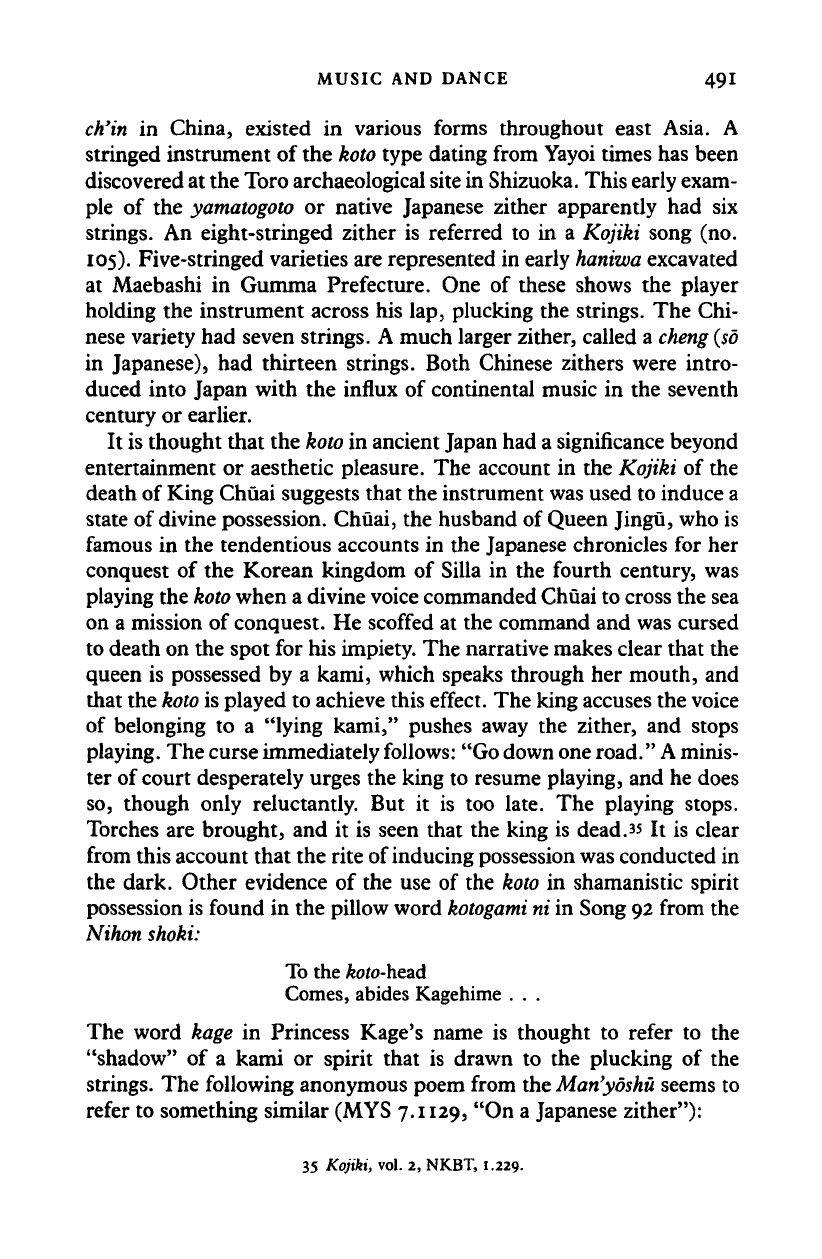
MUSIC AND DANCE 491
ch'in in China, existed in various forms throughout east Asia. A
stringed instrument of the
koto
type dating from Yayoi times has been
discovered at the Toro archaeological site in Shizuoka. This early exam-
ple of the
yamatogoto
or native Japanese zither apparently had six
strings. An eight-stringed zither is referred to in a Kojiki song (no.
105).
Five-stringed varieties are represented in early
haniwa
excavated
at Maebashi in Gumma Prefecture. One of these shows the player
holding the instrument across his lap, plucking the strings. The Chi-
nese variety had seven strings. A much larger zither, called a
cheng (so
in Japanese), had thirteen strings. Both Chinese zithers were intro-
duced into Japan with the influx of continental music in the seventh
century or earlier.
It is thought that the
koto
in ancient Japan had a significance beyond
entertainment or aesthetic pleasure. The account in the Kojiki of the
death of King Chuai suggests that the instrument was used to induce a
state of divine possession. Chuai, the husband of Queen Jingu, who is
famous in the tendentious accounts in the Japanese chronicles for her
conquest of the Korean kingdom of Silla in the fourth century, was
playing the
koto
when a divine voice commanded Chuai to cross the sea
on a mission of conquest. He scoffed at the command and was cursed
to death on the spot for his impiety. The narrative makes clear that the
queen is possessed by a kami, which speaks through her mouth, and
that the
koto
is played to achieve this effect. The king accuses the voice
of belonging to a "lying kami," pushes away the zither, and stops
playing. The curse immediately
follows:
"Go down one road."
A
minis-
ter of court desperately urges the king to resume playing, and he does
so,
though only reluctantly. But it is too late. The playing stops.
Torches are brought, and it is seen that the king is dead.35 It is clear
from this account that the rite of inducing possession was conducted in
the dark. Other evidence of the use of the
koto
in shamanistic spirit
possession is found in the pillow word
kotogami
ni in Song 92 from the
Nihon
shoki:
To the
koto-head
Comes, abides Kagehime . . .
The word kage in Princess Kage's name is thought to refer to the
"shadow" of a kami or spirit that is drawn to the plucking of the
strings. The following anonymous poem from the
Man'yoshu
seems to
refer to something similar (MYS 7.1129, "On a Japanese zither"):
35 Kojiki, vol. 2, NKBT, 1.229.
Cambridge Histories Online © Cambridge University Press, 2008
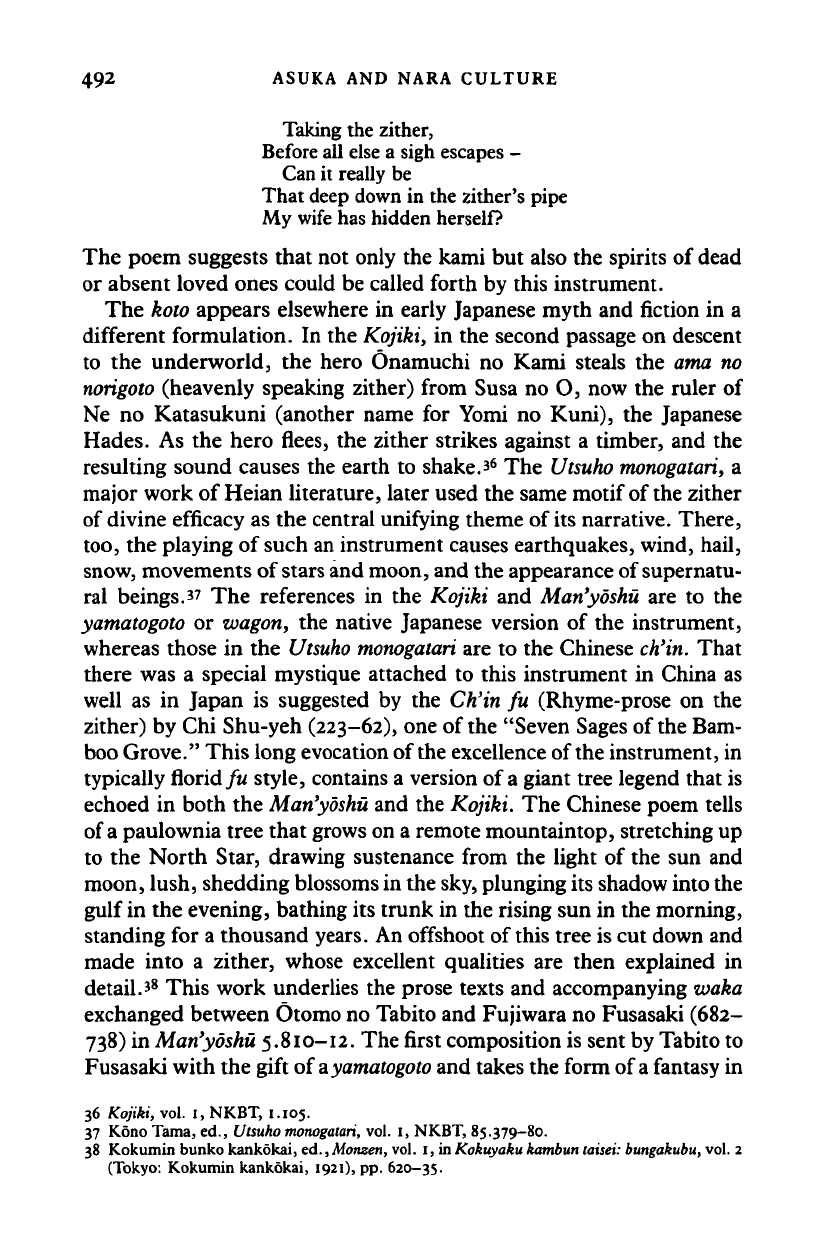
492 ASUKA AND NARA CULTURE
Taking the zither,
Before all else a sigh escapes -
Can it really be
That deep down in the zither's pipe
My wife has hidden herself?
The poem suggests that not only the kami but also the spirits of dead
or absent loved ones could be called forth by this instrument.
The koto appears elsewhere in early Japanese myth and fiction in a
different formulation. In the Kojiki, in the second passage on descent
to the underworld, the hero Onamuchi no Kami steals the ama no
norigoto
(heavenly speaking zither) from Susa no O, now the ruler of
Ne no Katasukuni (another name for Yomi no Kuni), the Japanese
Hades. As the hero flees, the zither strikes against a timber, and the
resulting sound causes the earth to shake.^
6
The
Utsuho
monogatari,
a
major work of Heian literature, later used the same motif of
the
zither
of divine efficacy as the central unifying theme of its narrative. There,
too,
the playing of such an instrument causes earthquakes, wind, hail,
snow, movements of stars and moon, and the appearance of supernatu-
ral beings." The references in the Kojiki and
Man'ydshii
are to the
yamatogoto
or wagon, the native Japanese version of the instrument,
whereas those in the
Utsuho monogatari
are to the Chinese
ch'in.
That
there was a special mystique attached to this instrument in China as
well as in Japan is suggested by the Ch'in fu (Rhyme-prose on the
zither) by Chi Shu-yeh (223-62), one of the "Seven Sages of the Bam-
boo Grove." This long evocation of the excellence of the instrument, in
typically
florid
fu style, contains a version of
a
giant tree legend that is
echoed in both the
Man'ydshii
and the Kojiki. The Chinese poem tells
of a paulownia tree that grows on a remote mountaintop, stretching up
to the North Star, drawing sustenance from the light of the sun and
moon, lush, shedding blossoms in the sky, plunging its shadow into the
gulf in the evening, bathing its trunk in the rising sun in the morning,
standing for a thousand years. An offshoot of
this
tree is cut down and
made into a zither, whose excellent qualities are then explained in
detail.3
8
This work underlies the prose texts and accompanying waka
exchanged between Otomo no Tabito and Fujiwara no Fusasaki (682-
738) in
Man'ydshii
5.810-12. The first composition is sent by Tabito to
Fusasaki with the gift of a
yamatogoto
and takes the form of a fantasy in
36 Kojiki,
vol. I,
NKBT,
1.105.
37
Kono
Tama,
ed.,
Utsuho
monogatari,
vol. 1,
NKBT, 85.379-80.
38
Kokumin bunko
kankokai, ed.,Monzen, vol. 1,
inKokuyaku kambun
taisei:
bungakubu,
vol.
2
(Tokyo:
Kokumin
kankokai, 1921),
pp.
620-35.
Cambridge Histories Online © Cambridge University Press, 2008
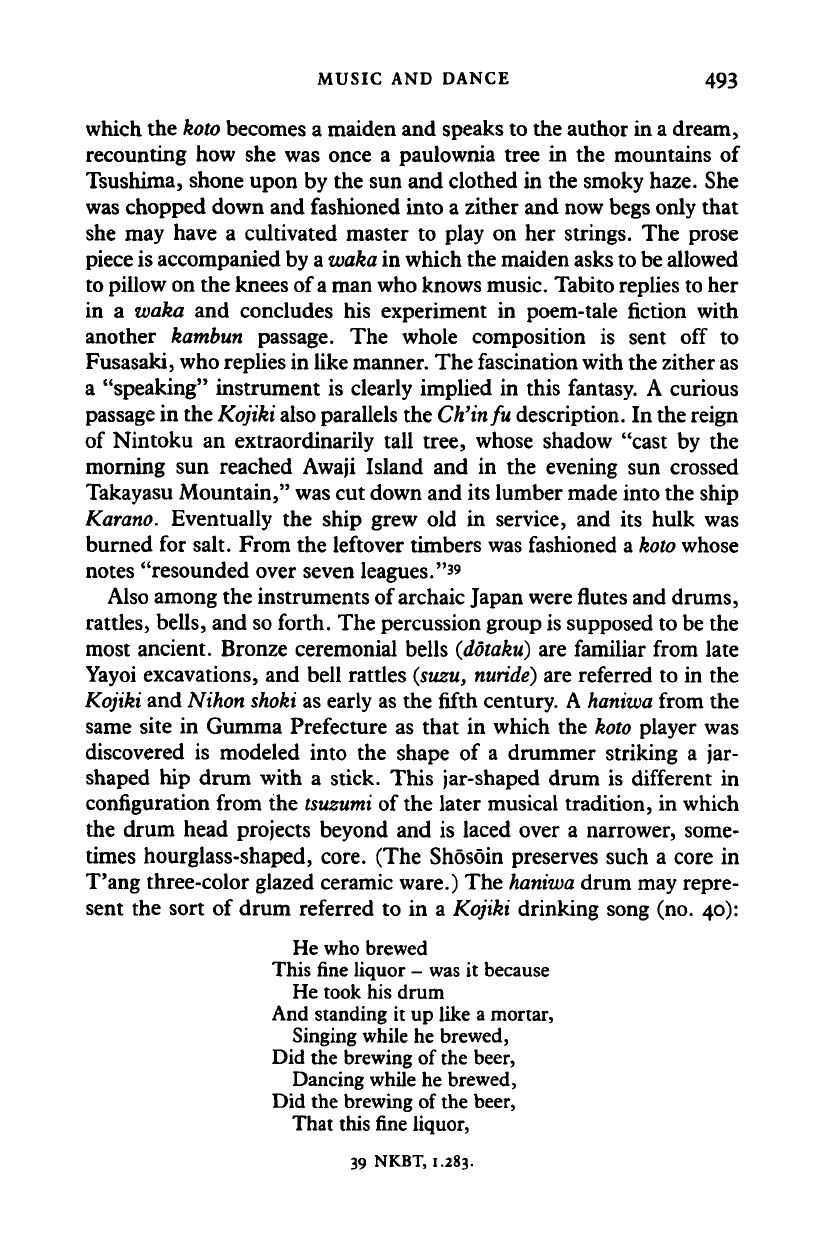
MUSIC AND DANCE 493
which the koto becomes a maiden and speaks to the author in a dream,
recounting how she was once a paulownia tree in the mountains of
Tsushima, shone upon by the sun and clothed in the smoky haze. She
was chopped down and fashioned into a zither and now begs only that
she may have a cultivated master to play on her strings. The prose
piece is accompanied by a waka in which the maiden asks to be allowed
to pillow on the knees of a man who knows music. Tabito replies to her
in a waka and concludes his experiment in poem-tale fiction with
another kambun passage. The whole composition is sent off to
Fusasaki, who replies in like manner. The fascination with the zither as
a "speaking" instrument is clearly implied in this fantasy. A curious
passage in the Kojiki also parallels the Ch'infu description. In the reign
of Nintoku an extraordinarily tall tree, whose shadow "cast by the
morning sun reached Awaji Island and in the evening sun crossed
Takayasu Mountain," was cut down and its lumber made into the ship
Karano. Eventually the ship grew old in service, and its hulk was
burned for salt. From the leftover timbers was fashioned a koto whose
notes "resounded over seven leagues."»
Also among the instruments of archaic Japan were flutes and drums,
rattles, bells, and so forth. The percussion group is supposed to be the
most ancient. Bronze ceremonial bells (dotaku) are familiar from late
Yayoi excavations, and bell rattles (stizu, nuride) are referred to in the
Kojiki and Nihon shoki as early as the fifth century. A haniwa from the
same site in Gumma Prefecture as that in which the koto player was
discovered is modeled into the shape of a drummer striking a jar-
shaped hip drum with a stick. This jar-shaped drum is different in
configuration from the tsuzumi of the later musical tradition, in which
the drum head projects beyond and is laced over a narrower, some-
times hourglass-shaped, core. (The Shosoin preserves such a core in
T'ang three-color glazed ceramic ware.) The haniwa drum may repre-
sent the sort of drum referred to in a Kojiki drinking song (no. 40):
He who brewed
This fine liquor - was it because
He took his drum
And standing it up like a mortar,
Singing while he brewed,
Did the brewing of the beer,
Dancing while he brewed,
Did the brewing of the beer,
That this fine liquor,
39 NKBT, 1.283.
Cambridge Histories Online © Cambridge University Press, 2008
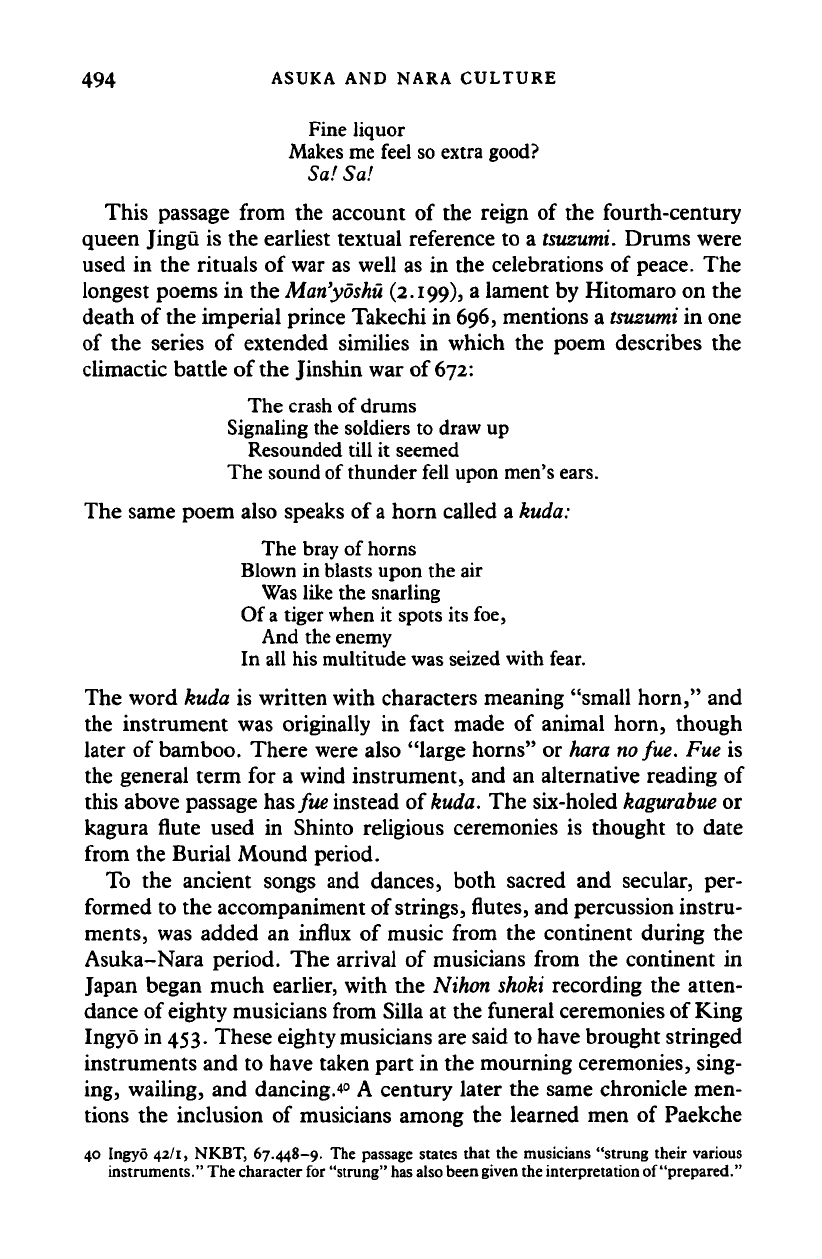
494 ASUKA AND NARA CULTURE
Fine liquor
Makes me feel so extra good?
5a/ Sa!
This passage from the account of the reign of the fourth-century
queen Jingu is the earliest textual reference to a
tsuzumi.
Drums were
used in the rituals of war as well as in the celebrations of peace. The
longest poems in the
Man'yoshu
(2.199), a lament by Hitomaro on the
death of the imperial prince Takechi in 696, mentions a
tsuzumi
in one
of the series of extended similies in which the poem describes the
climactic battle of the Jinshin war of
672:
The crash of drums
Signaling the soldiers to draw up
Resounded till it seemed
The sound of thunder fell upon men's ears.
The same poem also speaks of
a
horn called a kuda:
The bray of horns
Blown in blasts upon the air
was like the snarling
Of
a
tiger when it spots its foe,
And the enemy
In all his multitude was seized with fear.
The word kuda is written with characters meaning "small horn," and
the instrument was originally in fact made of animal horn, though
later of bamboo. There were also "large horns" or
hara no
fue. Fue is
the general term for a wind instrument, and an alternative reading of
this above passage has fue instead of
kuda.
The six-holed
kagurabue
or
kagura flute used in Shinto religious ceremonies is thought to date
from the Burial Mound period.
To the ancient songs and dances, both sacred and secular, per-
formed to the accompaniment of
strings,
flutes, and percussion instru-
ments, was added an influx of music from the continent during the
Asuka-Nara period. The arrival of musicians from the continent in
Japan began much earlier, with the Nihon
shoki
recording the atten-
dance of eighty musicians from Silla at the funeral ceremonies of King
Ingyo in
453.
These eighty musicians are said to have brought stringed
instruments and to have taken part in the mourning ceremonies, sing-
ing, wailing, and dancing.*
0
A century later the same chronicle men-
tions the inclusion of musicians among the learned men of Paekche
40 Ingyo
42/1,
NKBT, 67.448-9. The passage states that the musicians "strung their various
instruments." The character for "strung"
has
also been given the interpretation of "prepared."
Cambridge Histories Online © Cambridge University Press, 2008
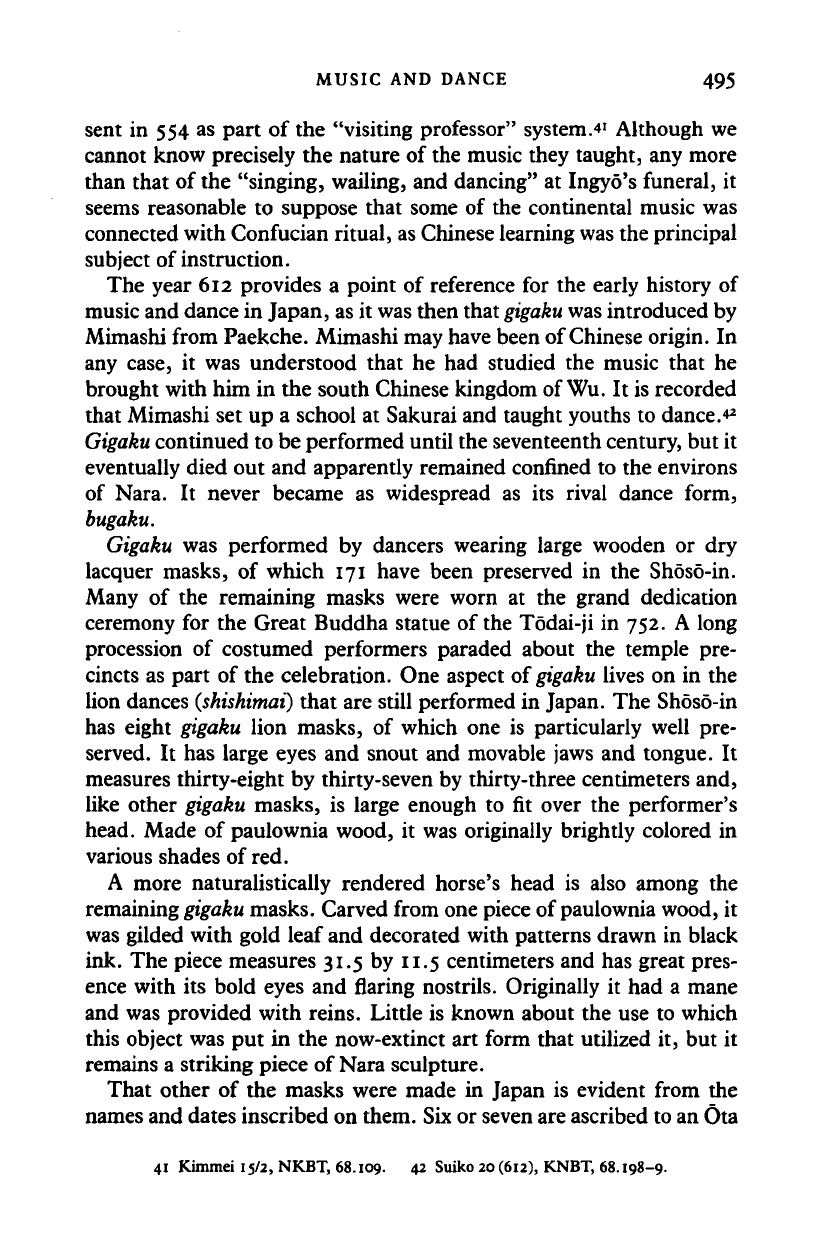
MUSIC AND DANCE 495
sent
in
554
as
part
of
the "visiting professor" system.*' Although
we
cannot know precisely the nature
of
the music they taught, any more
than that
of
the "singing, wailing, and dancing"
at
Ingyo's funeral,
it
seems reasonable
to
suppose that some
of
the continental music
was
connected with Confucian ritual, as Chinese learning was the principal
subject
of
instruction.
The year 612 provides
a
point
of
reference
for the
early history
of
music and dance in Japan, as
it
was then that
gigaku
was introduced by
Mimashi from Paekche. Mimashi may have been of Chinese origin.
In
any case,
it was
understood that
he had
studied
the
music that
he
brought with him
in
the south Chinese kingdom of
Wu.
It
is recorded
that Mimashi
set up a
school
at
Sakurai and taught youths to dance.*
2
Gigaku
continued to be performed until the seventeenth century, but it
eventually died
out and
apparently remained confined
to
the environs
of Nara.
It
never became
as
widespread
as its
rival dance form,
bugaku.
Gigaku
was
performed
by
dancers wearing large wooden
or dry
lacquer masks,
of
which
171
have been preserved
in the
Shoso-in.
Many
of the
remaining masks were worn
at the
grand dedication
ceremony
for the
Great Buddha statue
of
the Todai-ji
in
752. A long
procession
of
costumed performers paraded about
the
temple
pre-
cincts
as
part
of
the celebration. One aspect
of
gigaku
lives
on in the
lion dances
(shishimai)
that are still performed
in
Japan.
The
Shoso-in
has eight gigaku lion masks,
of
which
one is
particularly well
pre-
served.
It has
large eyes
and
snout
and
movable jaws
and
tongue.
It
measures thirty-eight
by
thirty-seven by thirty-three centimeters and,
like other
gigaku
masks,
is
large enough
to fit
over
the
performer's
head. Made
of
paulownia wood,
it
was originally brightly colored
in
various shades
of
red.
A more naturalistically rendered horse's head
is
also among
the
remaining
gigaku
masks. Carved from one piece of paulownia wood,
it
was gilded with gold leaf and decorated with patterns drawn
in
black
ink. The piece measures 31.5
by
11.5 centimeters and has great pres-
ence with
its
bold eyes
and
flaring nostrils. Originally
it had a
mane
and was provided with reins. Little
is
known about
the
use
to
which
this object was
put in the
now-extinct
art
form that utilized
it, but it
remains
a
striking piece
of
Nara sculpture.
That other
of the
masks were made
in
Japan
is
evident from
the
names and dates inscribed on them. Six or seven are ascribed to an Ota
41 Kimmei 15/2, NKBT, 68.109.
42
Suiko 20 (612), KNBT, 68.198-9.
Cambridge Histories Online © Cambridge University Press, 2008
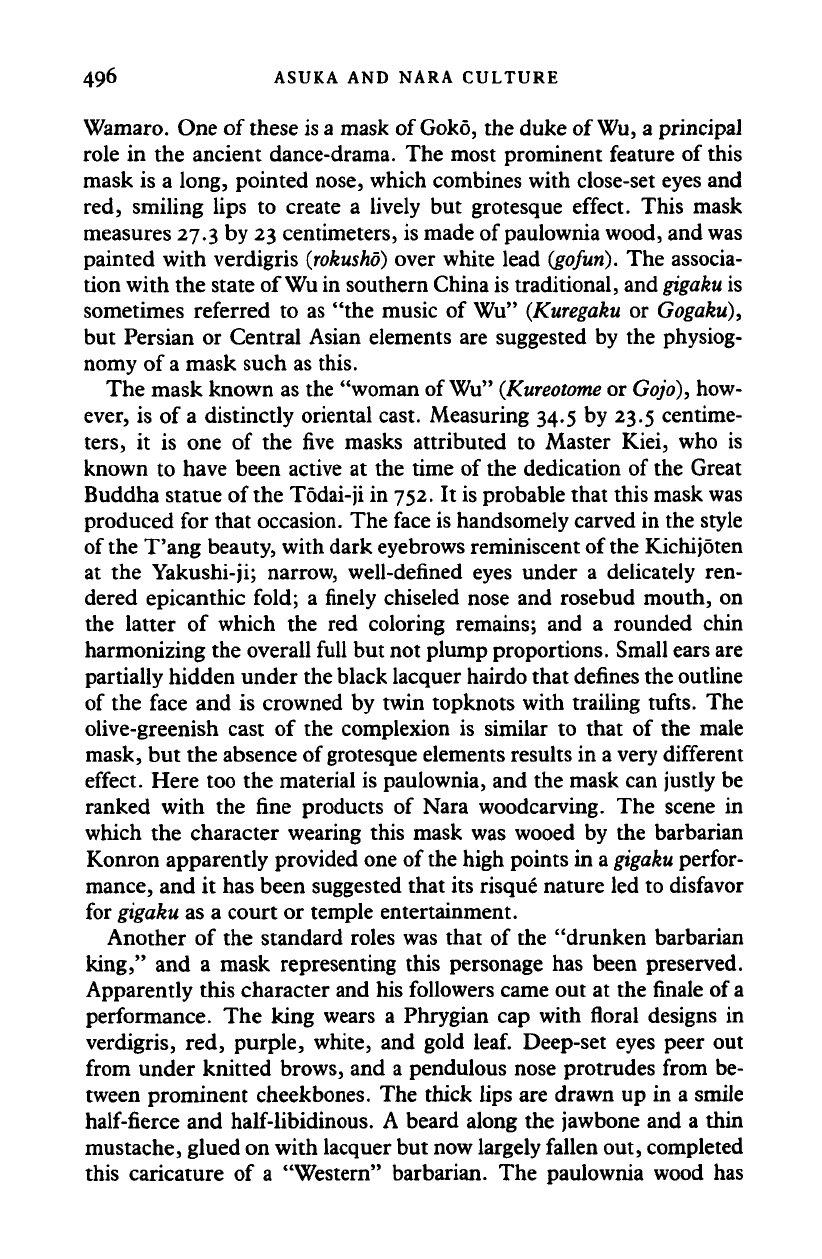
496 ASUKA AND NARA CULTURE
Wamaro. One of these is a mask of
Goko,
the duke of Wu, a principal
role in the ancient dance-drama. The most prominent feature of this
mask is a long, pointed nose, which combines with close-set eyes and
red, smiling lips to create a lively but grotesque effect. This mask
measures 27.3 by 23 centimeters, is made of paulownia wood, and was
painted with verdigris
(rokusho)
over white lead
igofun).
The associa-
tion with the state of Wu in southern China is traditional, and
gigaku
is
sometimes referred to as "the music of Wu"
(Kuregaku
or Gogaku),
but Persian or Central Asian elements are suggested by the physiog-
nomy of
a
mask such as this.
The mask known as the "woman of
Wu"
(Kureotome
or
Gojo),
how-
ever, is of a distinctly oriental cast. Measuring 34.5 by 23.5 centime-
ters,
it is one of the five masks attributed to Master Kiei, who is
known to have been active at the time of the dedication of the Great
Buddha statue of the T6dai-ji in 752. It is probable that this mask was
produced for that occasion. The face is handsomely carved in the style
of the T'ang beauty, with dark eyebrows reminiscent of
the
Kichijoten
at the Yakushi-ji; narrow, well-defined eyes under a delicately ren-
dered epicanthic fold; a finely chiseled nose and rosebud mouth, on
the latter of which the red coloring remains; and a rounded chin
harmonizing the overall full but not plump proportions. Small ears are
partially hidden under the black lacquer hairdo that defines the outline
of the face and is crowned by twin topknots with trailing tufts. The
olive-greenish cast of the complexion is similar to that of the male
mask, but the absence of grotesque elements results in a very different
effect. Here too the material is paulownia, and the mask can justly be
ranked with the fine products of Nara woodcarving. The scene in
which the character wearing this mask was wooed by the barbarian
Konron apparently provided one of the high points in a
gigaku
perfor-
mance, and it has been suggested that its risque nature led to disfavor
for
gigaku
as a court or temple entertainment.
Another of the standard roles was that of the "drunken barbarian
king," and a mask representing this personage has been preserved.
Apparently this character and his followers came out at the finale of
a
performance. The king wears a Phrygian cap with floral designs in
verdigris, red, purple, white, and gold
leaf.
Deep-set eyes peer out
from under knitted brows, and a pendulous nose protrudes from be-
tween prominent cheekbones. The thick lips are drawn up in a smile
half-fierce and half-libidinous. A beard along the jawbone and a thin
mustache, glued on with lacquer but now largely fallen out, completed
this caricature of a "Western" barbarian. The paulownia wood has
Cambridge Histories Online © Cambridge University Press, 2008
